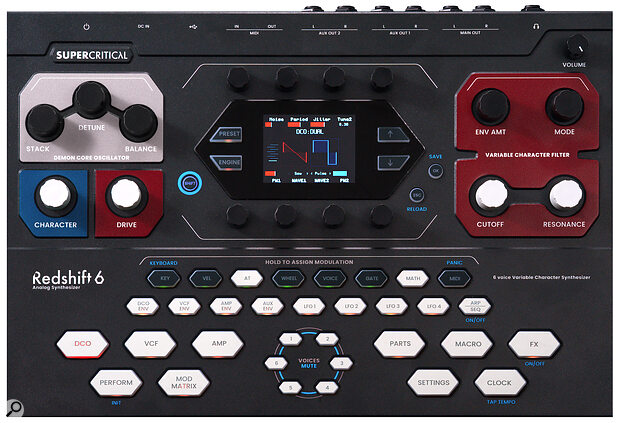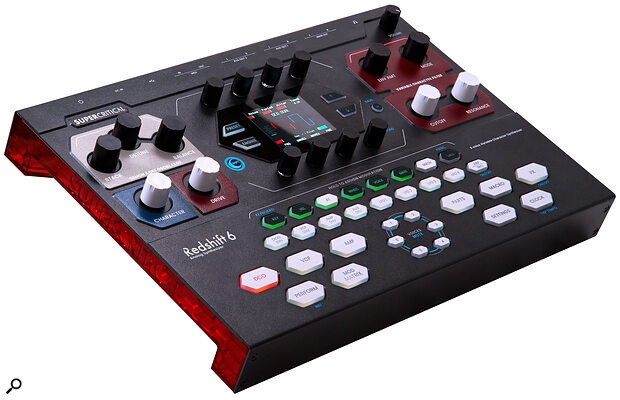Like a medieval cathedral, the Redshift 6 is a massively ambitious creation. There are other similarities too...
If you’re a modular user, you may recognise the name Supercritical from their two Eurorack offerings, the Demon Core Oscillator and Neutron Flux Filter (reviewed in SOS Jan 2020 and Dec 2021 respectively); two modules of formidable power that bring the worlds of analogue and digital together with finesse. If you happen to own either of those two modules, you will likely be pleased to know that they are both key constituents of the Redshift 6, the company’s first polyphonic desktop synthesizer and nothing if not a powerful statement of intent. It’s worth acknowledging early on that there’s also the distinct possibility that you’ve seen the Redshift 6 doing the rounds for some time already. Even when featured on the SOS YouTube series at Superbooth 2025 it had already been out for some time; and in fact was even on display at the Superbooth before that.
Why, then, are we only publishing a review of it now? Well, it comes down to a simple, endemic issue with the electronic instrument industry, about which I have in previous reviews made my feelings clear. Upon its release the Redshift 6 was, in simple terms, not finished. And, depending on your perspective, it might still be described as not finished. I say this for reasons which will become clear, but for now I’ll leave it at the fact that key buttons, such as FX, yield only a message saying ‘coming soon’, and I’d hazard a guess that anyone who bought a Redshift 6 upon its release will be starting to wonder what ‘soon’ really means.
Hex Appeal
In any case, I do have a synth before me, in the flesh. What is it? Well, its not trying to emulate anything that’s come before, that’s for sure. On the chassis it says it’s a ‘six‑voice variable character synthesizer’. Each of its six voices comprises a staggering 16 digitally controlled analogue oscillators, including one for white noise. The interface itself strikes me, if I’m honest, as a little dated‑looking, with its big rubbery hexagonal buttons, small screen and transparent red plastic sides; more at home next to 2005’s Roland V‑Synth XT than next to my Torso S‑4 sampler or Make Noise 0‑Coast. But who knows, in a few years it might be aesthetically on trend again, as these things often go. Plus the sides light up, which I will never complain about. What’s important is that the build quality here is substantial and leaves nothing to be desired.
The workflow of the Redshift 6 ostensibly revolves around the screen and its accompanying soft knobs, with the panel buttons used to access its various screens. A handful of large endless encoders on either side of the panel then provide instant access to key parameters: on the right side are controls for the filter, including cutoff, resonance, filter mode and envelope amount, and on the left are controls for overdrive, ‘Character’ (discussed anon), and oscillator stacking, detuning and balance. At the bottom are buttons for things like viewing the DCO details and filter cutoff. The closest thing to a ‘home screen’ is that called up by the Perform button, which displays a handful of useful parameters simultaneously such as the active preset, bpm and drive amount. A ring of buttons at the bottom of the panel is labelled Voices. Although, confusingly, these in fact are for editing parts, not voices, they are well positioned and do make quick work of accessing the Redshift 6’s various layers.
 The Redshift 6 measures 378 x 254 x 63mm and weighs 3.5kg. And the sides light up!
The Redshift 6 measures 378 x 254 x 63mm and weighs 3.5kg. And the sides light up!
I should say: it all really works. My fears of menu‑diving were all but allayed when I happily came to realise that more or less all screens were only one layer deep, and even more convenient is the modulation matrix workflow, which if desired can involve simply holding the relevant modulation source button (this could be the mod wheel, one of four LFOs, any of the envelopes, and so forth) and moving almost any parameter to have it modulated by that source. This presumably also...
You are reading one of the locked Subscribers-only articles from our latest 5 issues.
You've read 30% of this article for FREE, so to continue reading...
- ✅ Log in - if you have a Digital Subscription you bought from SoundOnSound.com
- ⬇️ Buy & Download this Single Article in PDF format £0.83 GBP$1.49 USD
For less than the price of a coffee, buy now and immediately download to your computer, tablet or mobile. - ⬇️ ⬇️ ⬇️ Buy & Download the FULL ISSUE PDF
Our 'full SOS magazine' for smartphone/tablet/computer. More info... - 📲 Buy a DIGITAL subscription (or 📖 📲 Print + Digital sub)
Instantly unlock ALL Premium web articles! We often release online-only content.
Visit our ShopStore.

